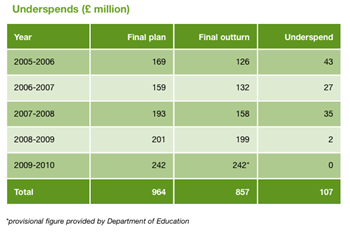School building underspend
Despite generous funding for school buildings, £107 million was not spent and money is now in shorter supply. agendaNi analyses the underspend.
The Audit Office has found a “pressing need to progress” capital investment in schools after major under-spending. Its ‘School Design and Delivery’ report explains that £107 million set aside for school building work between 2005 and 2010 was not used. The money was sent back to the Executive’s central funds.
Most of the underspend took place under direct rule, with the devolved Education Minister making sure that almost all the money is now spent each year. However, after those years of plenty, major cuts are on the way for the capital budget.
Initially, the Department of Education was allocated £1.2 billion for capital spending between 2005 and 2010, but the final sum spent was £857 million.
The difference (£353 million) can be broken down into two categories:
• £246 million due to in-year reductions in the department’s budget;
• the £107 million underspend.
If the underspend had been used, the total spending would have reached £964 million.
Historically, £1.4 billion was spent between 1997 and 2006. A total of
£3.4 billion in spending over 2008-2018 was envisaged in the Investment Strategy. Cuts have started (£22 million in 2010-2011) and further reductions, rather than rises, are anticipated.
Officials put the underspend down to legal problems around site acquisitions, delays in approvals from government agencies, ongoing reviews of long-term pupil enrolments and a legal challenge to the department’s construction procurement framework.
Any underspends are returned to the Executive at the end of the financial year, so that ministers can decide how to spend the money elsewhere in the province.
Under-investment
Capital projects must be approved by the Education Minister, who will continue to make those decisions after the Education and Skills Authority (ESA) is set up. However, the authority will produce area-based plans and strategic investment plans, which will help to set priorities for capital investment.
“Design alone,” the Audit Office points out, “cannot raise educational achievement, but poor design can be an obstacle to raising educational standards.” Teachers and principals, in brief, should be free to focus on children’s needs rather than the state of their school buildings.
A long of history of backlogs built up after years of under-investment. This repair bill was estimated at £114 million in 1995 and increased to £292 million in 2009 i.e. £900 per pupil.
Back in the 1990s, around £30 million to £50 million was being spent on major capital works each year. Over half of the estate was not fit for purpose.
In April 2004, the department announced that it was investing £222 million, to clear up the “existing known capital needs backlog” by 2010. Just 12 of the 42 schemes in this programme have been delivered to date. However, the number of mobile classrooms halved from nearly 3,000 in 2005 to 1,500 in 2009.
Strategic partnership
In 2005, the Strategic Investment Board and Department of Education jointly published ‘New Procurement and Delivery Arrangements for the Schools Estate’. This report, commissioned from PwC, recommended:
• A whole-system approach to planning rather than sector-by-sector;
• Setting up four ‘strategic partnership’ areas across Northern Ireland;
• A private sector partner and 10-year strategic investment plan for each area;
• Seven to 10-year contracts for maintenance and facilities management; and
• Exclusive construction rights assigned to the partner (subject to past performance).
A ‘dedicated education infrastructure procurement service’ would also be set up, bringing together relevant staff from across the system. PwC estimated that this would make 10 per cent savings in capital costs and that the recommendations could be carried out within 40 months.
However, the Audit Office found that these reforms have not occurred. Asked why the 2005 report was not implemented, the Department of Education said it could not comment as the Audit Office’s findings could be considered by the Public Accounts Committee.
Construction work took place against a backdrop of smaller numbers of pupils in schools. The overall school population peaked at 354,230 in 1996-1997 and fell to 322,713 in 2009-2010. Numbers are expected to pick up again by around 2020.
MLAs on the first Assembly’s Public Accounts Committee warned that public money was being spent on empty places rather than improving full classrooms. There were 35,000 empty desks in 1999-2000, which rose to 54,000 in 2008-2009.
The Bain report in 2006 found that there were too many schools overall and also too many schools with small rolls. Its ultimate aim was therefore fewer and larger schools. Minimum sizes for new schools were subsequently adopted, which resulted in eight capital schemes being withdrawn.
Delays are now the main problems holding up projects. Planning, procurement and legal problems are cited by the department. This means that progress is “slower than expected” despite the large financial allocation.
Design quality in completed projects was praised by auditors as “very strong” and most schools could also be used by local communities in the evenings or at weekends. Extended schools are one example. However, most schools do not open out-of-hours, because of problems with insurance, staffing, maintenance and security.
The Audit Office’s findings are based on an independent assessment of 11 primary schools, four post-primary schools and one special school built or refurbished between 1999 and 2008, at a total value of £100.5 million. A total of 153 projects were completed between 1997 and December 2009.
Great expectations
The Investment Strategy naturally would have raised expectations, some of which will not be met due to past underspends and future cuts.
“Persistent over-optimism” along with “poor planning” also led to disappointment in the Building Schools for the Future programme over in England. The criticism was made by the Commons Public Accounts Committee in May 2009. Launched in 2004, the programme pledged 200 rebuilt secondary schools by December 2008 but just 42 were completed on time. Education Secretary Michael Gove scrapped the programme in July.







